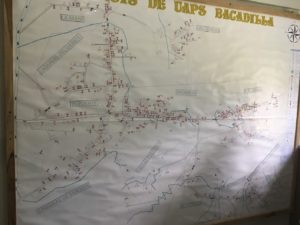SITE NAVIGATION
Closing Assessments
Community Assessment:
The community assessment ensures that a bridge is the right solution for the community, and that the community is able take care of the bridge after it is built. After gathering information and getting to know the community on the site visit, we asked three questions.
Is this solution right for the community?
If the clinic was not serving its constituents well, or if residents were not attending appointments, a bridge would not suddenly create the perfect circumstances for the community. On the contrary, the clinic is quite effective.
- Patients regularly attend their appointments
- Patients take part in social groups
- Communication between the clinic and patients is strong
The very last problem is that, once residents reach the clinic, they simply cannot cross the river safely in order to attend their appointment.
Is the community invested?
The bridge will not be successful unless the community has a stake. Members of the community expressed their desire to have the bridge, actively taking part in the congregations we held in Bacadillas. The community has banded together in the past to help with a similar project, bridging to a soccer field. Furthermore, there are several well-respected leaders in the community who can rally residents to assist with upkeep in the future.
How will the design change to adapt to community needs?
Our original design plan was a suspended or suspension bridge, as they are cheaper and easy to build given the site conditions and unknown construction timeline. However, there was potential for the tiebacks of the cables to infringe upon the private property of the two families living directly adjacent to the bridge. As such, the design team headed in a new direction, eventually settling on a stringer bridge, which best considered the needs of the community, as well as constructability.
- The design progression as a result of considering the community’s needs
Environmental Assessment:
The environmental assessment examines both the carbon impacts of the project and the impact on the local ecosystem. A goal during the design process was to remain environmentally conscious of this impact and minimize any negative effects when able.
- Using recycled steel!
- Results in approximately 5.6-tonnes of carbon emissions
- Minimize steel usage with wood railings
- Local resources
- Less transportation means less emissions
- Support the local economy
- Utilizing perimeter control barriers to control erosion and water runoff
- Minimizing disturbed area to control sedimentation
- Store and stockpile materials away from the construction site to reduce contamination from water runoff
Cost Assessment:
Throughout the bridge’s design, cost was always minimized without compromising safety or design quality. Some of the ways in which costs were reduced include:
- The use of long, continuous spans to lessen the number of expansion joints and bearings required, consequently limiting the future maintenance costs accompanied by these design aspects (CITE)
- Minimizing the bridge span while complying with freeboard requirements
- Choosing the most economical and effective beam shape
- Maximizing the use of locally sourced materials, such as in the design of railing components
The table below provides a summary of the design’s most significant cost categories. The overall bridge construction is expected to cost $30,770, which includes transportation expenses associated with all the materials needed.
- Cost Summary





